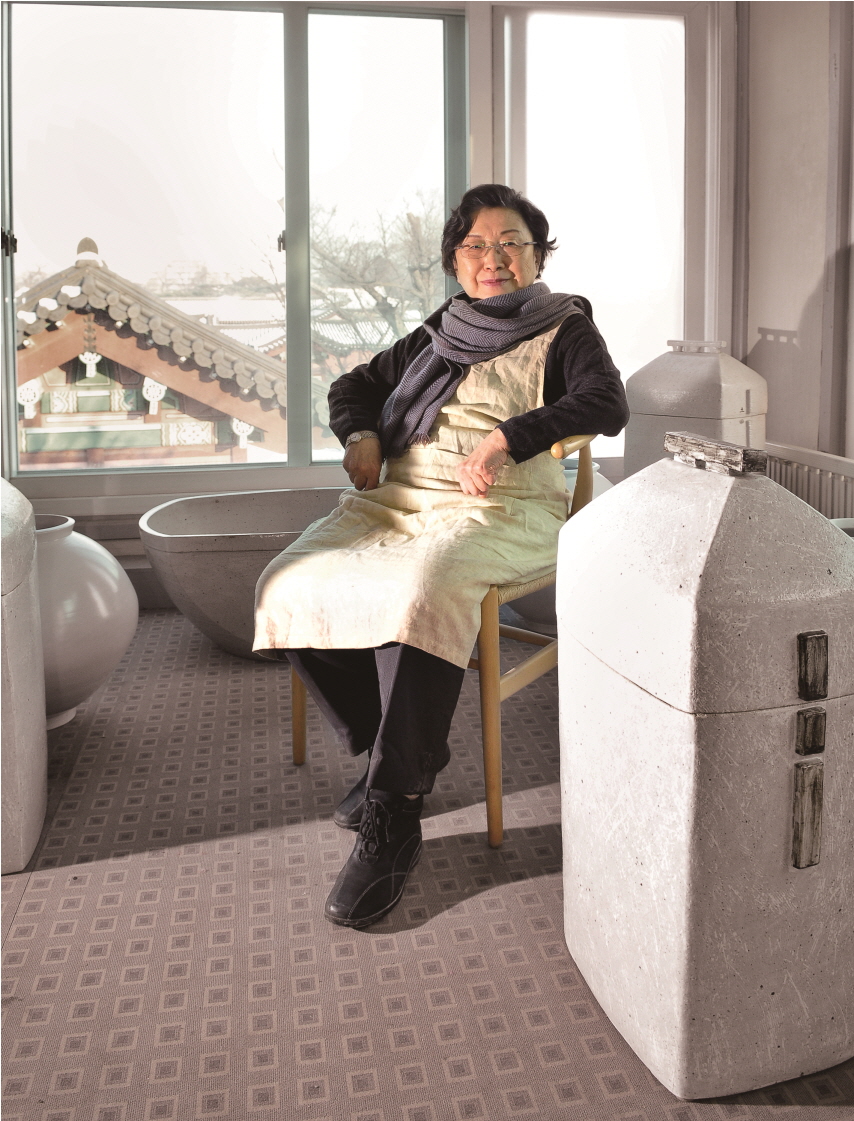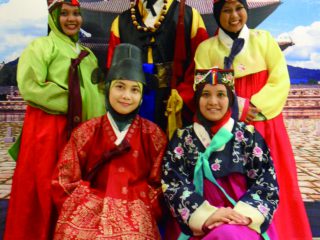Kim Yikyung
Ceramic artist brings a modern touch to an ancient art
Written by Robert Koehler
Photographed by Ryu Seunghoo
“White porcelain represents Koreans. In the old days, Korean used to wear all white.”
One of Korea’s most respected ceramics artists, Kim Yikyung has been a pioneer in the ceramic arts. With over five decades of work, she has striven endlessly to bring Korea’s ceramic heritage into the modern world. Her work, inspired by the pure white baekja (“white porcelain”) of the Joseon Dynasty (1392–1592), has been lauded worldwide for its harmonization of tradition and modern sensibilities.
Appreciating what you have
Despite Korea’s centuries-old ceramics tradition, it wasn’t easy for Kim to become a ceramist, especially in 1950s Korea. “At first, I majored in chemical engineering. In the 1950s, all of Korea’s industries were in the beginning stages. Ceramics, the industry behind the ceramic arts, was no different. I took interest in ceramics production from the industrial perspective, but I grew fascinated with the beauty of ceramics, and so became a ceramics artist.”
Just learning about ceramics at that time was a challenge, however. The Korean ceramics industry had all but been destroyed during the first half of the 20th century, and few places offered instruction on ceramic arts. The United States and Japan, however, offered more opportunities in this regard, so Kim went overseas, first to New York’s Alfred University and later to Japan, a nation known for both its love of Korean ceramics and respect for the ceramics profession.
While at Alfred University, she attended a lecture by British ceramics artist Bernard Leach, considered one of the greatest Western ceramicists of the 20th century. Hong Kong-born and Japanese-trained, Leach was intimately tied to the folk arts movement of early 20th century Japan. Korean ceramics—and the ceramics of the Joseon Dynasty in particular—was held in great regard within the movement for its rustic, craftsmanlike beauty. In his lecture, Leach pointed to Joseon Dynasty baekja as the aesthetic ideal that modern ceramics should aim for. And with this, Kim found her calling.
No mere recreations
In the 1960s, Joseon baekja ceramics was a virtual terra nullius. Kim recalls, “In our school textbooks, we learned about Goryeo celadon, but there was nothing about Joseon baekja,” Baekja was the pure white porcelain favored by the Joseon Dynasty’s aristocratic elite. Its pure white color and restrained beauty were praised as an artistic expression of neo-Confucianism, the ruling ideology of the kingdom. Despite the respect shown for it overseas, Korean art historians had given it short thrift in favor of the more elegant, Buddhist inspired designs of the Goryeo Dynasty’s jade-colored celadon. Kim had to perform a lot of research on her own, including a three-year stint examining the Joseon baekja collection of the National Museum of Korea.
Kim is quick to note that her artwork is no mere recreation of Joseon Dynasty baekja. “I don’t produce Joseon baekja,” she says. “I also don’t recreate it. My production method, materials, and form do not recreate Joseon baekja in the traditional fashion. My connection with Joseon baekja is elsewhere.”
That connection, she explain, is in borrowing the artistic motifs of Joseon baekja, and then recreating them. “Joseon baekja is highly praised not just for its form and shine, but also because it maintains its naturalness and simplicity at every level and allows ordinary people to use it as, say, dining implements, while the pieces themselves adopt the most beautiful crude elements possible.”
To her (and Bernard Leach), Joseon baekja opened the way for modern ceramics. “Prior to Joseon baekja, pieces of ceramic art were not used in daily life. In that it struck a balance between art and general use, we can say Joseon baekja had already realized the task pursued by modernism to create a coexistence between distinction and universality.”
To Kim, this coexistence of aesthetic beauty and general practicality is the artistic philosophy behind Joseon baekja and the governing philosophy behind her own work. “I find my inspiration in Joseon baekja, as well as classical art, crafts and tools in regions like Africa and India where tradition still lives, and natural scenery,” she says. This is where she finds and discovers her artistic fundamentals. “This is not just aesthetic information or something physical. I call it ‘core elements,’” she explains. “To find and define these core elements, it’s more important for a person to perceive them on the inside rather than see them from the outside. You can find true beauty only if you ask yourself what the basis of beauty is and think about it.”
Once she’s found the fundamentals, she can begin work. “After I’ve extracted the core elements, I conceptualize or plan a work by reconceptualizing those elements. I sketch them out or make a trial piece. In this way works are made that reflect these reconceptualized core elements. This process chain could be called creation as carried out by an artist.”
A look at Kim’s work reveals this process. Her work can generally be divided into four categories: vessels, lidded forms, ritual pedestals, and objects. All reveal the clear influence of baekja, but the forms are distinctively modern, tailored to a modern-day aesthetic.
Future of Korean ceramics
Kim sees a global future for Korean ceramics. “Koreans are good with their hands. They say we have a craft technique,” she says. “But craft technique cannot guarantee the future. Korea has a more valuable culture that it has kept for a long time: its frankness towards work, its self honesty, and its naturalism that seeks harmony with nature. This culture helps create an attitude of approaching the fundamentals in whatever Koreans do.”
Kim believes Koreans need to protect and develop this culture. “We don’t need to protect and preserve things just because they are old. We need to protect and develop things because they have value. This Korean culture is a global idea we can share with all humanity.”
Wooilyo Gallery Shop | 우일요
FYI>
Hours: Mon–Fri 9:30am–6:30pm,
Sat 9:30am–5pm
T. 02-763-2562, www.wooilyo.com
GO>
Anguk Station 안국역 (Line 3), Exit 3







